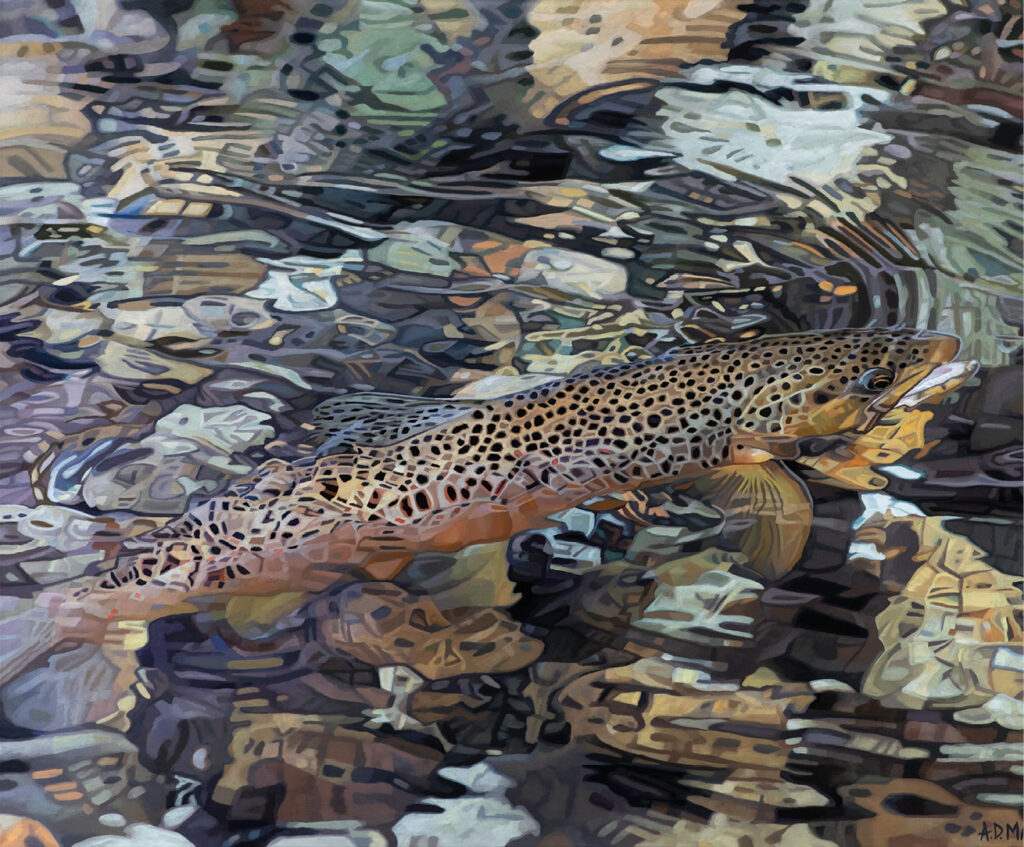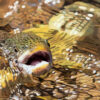The afternoon didn’t get off to a great start. There were the extra phone calls I had to make before sneaking out of the office. Then I had to rush to pack fly rods, flies and other necessities for a quick trip to fish the South River in Greene County, Va. And finally, there was the single-lane bridge under construction that my GPS failed to account for, and while I measured the resulting delay in minutes, it felt like hours to me.
Fortunately, my earlier aggravation subsided as I turned off the gravel road and meandered down the lane that led to the stream. Driving past native grasses and newly planted fields, all green and alive from the prior night’s rain and warm spring temperatures, further soothed my restless mind even though I couldn’t help but tick through an inventory of my hastily packed gear.
I arrived at the parking area—a small patch of mowed grass alongside the mile-and-a-half section of the South River that is accessible to anglers and stocked with large rainbow trout. It was my first time on this strip of private water, which is managed by our local fly shop and open to members who pay to access five different rivers scattered throughout the region. My friend Rob Staunton had recently invited me to fish another property managed by the fly shop on Buffalo Creek in rural Rockbridge County, and I was so impressed with the experience that I decided to join the collective.
Now in my second decade as a fly fisherman, I’m selective in how I spend my time on the water. My early years were marked with trips in which I reveled in the pure joy of casting a fly rod. I loved false casting from the bow of a flats boat as much as I embraced the challenge of delicately placing a size 12 dry fly under the treacherous reaches of a snaggy Rhododendron branch on a North Carolina stream. The idea that catching fish was secondary to the delight of just being out on the water has given way to my expectations that fishing trips should result in caught fish.
Trout fishing in the Commonwealth can be a mixed bag. Our state fish is the brook trout, which are native and inhabit many of the streams throughout the Shenandoah Valley and Blue Ridge Mountains. Recreational trout fishing here is mostly dependent on regular stockings, and brown and rainbow trout are the most supplied fish. Warmer summer weather and resulting low water levels generally mean very few of these stocked fish survive from season to season. For most managed waters, fishing usually wraps up by the end of May or early in June depending on rainfall and temperatures.
A recent cold front and a wet spring gave me hope that the South River was going to have enough water to keep the larger trout holed up in the deeper pools where the water was cooler and the food more plentiful. As I walked to the riverbank, I couldn’t help but notice the heat that seemed to radiate up through my wading boots and into the closed confines of my waders. A more prepared angler would have checked the weather and decided fishing without waders would be a more sensible plan.
My excitement began to build as I approached the river, and I was confident today was a good day to fish. In recent years, fishing has played a less prominent role in my life. For me, family, work and my new love of upland hunting have all resulted in less time on the water. Despite these realities, my love for fly fishing is strong.
The riverbank was overgrown but passable, and the trees provided refuge from the afternoon sun. I stepped into the stream and my heart sank a bit when the water barely reached my knees, and I knew it wouldn’t hold fish. Today I would have to find the pools and fish them hard.
Undeterred, I released my fly and began to work areas I believed may be productive. As I methodically fished in front of me and waded downstream, I remembered that fly fishing is an optimistic pursuit. Anyone who has cast a fly rod knows there’s always hope; your next cast may hook a hungry fish—or you may find the perfect pool around the next bend. I thought about these ideas as I reached the final bend in the river.
To access the last stretch of fishable water, I had to cross the river and walk along the fields that shouldered the other side. I stepped on the rock-strewn riverbed and was aware of storm clouds developing in the distance, a byproduct of the heat and humidity of a late spring day. I didn’t want to get caught in a thunderstorm and decided to take a quick look and a few casts were all I had time for before returning to my vehicle. Disappointed by the lack of action on the river, I neared the final hole somewhat discouraged by the day’s outcome.
I approached with the sound of distant thunder in my ears, determined to make one last cast. The stream coursed through an oxbow bend, and large exposed bedrock at the far end slowed the flow and held water. I could tell the water was deep and cool, an ideal spot for trout on a warm afternoon. The lower water levels I encountered earlier in my journey had drawn fish here, and the white foam line following the river’s current into the pool was a clear indication that these fish were able to find the nutrition they needed to survive.
Within moments of my first cast, I landed a beautiful trout, nearly as large as the 24-inch opening in the mouth of my net, a worthy opponent for my slight 4-weight rod. The darkening skies and the audible rumbling served as a reminder that my time on this pool was short. A few more casts yielded a second large trout on a blue-winged olive that mimicked the afternoon hatch that attracted fish to the surface. I became more excited with each cast—and felt an urge for haste as the storm became more real.
Rain fell and I retrieved my line. I marveled at trout that continued to swim beneath the surface. They did not care about the storm and remained active as I studied them through my polarized lenses. Then I heard the crack of thunder overhead, and I retreated to the safety of my car. There were so many fish in that pool, but it was time to go.
For more information on the Albemarle Angler’s private fly-fishing club, Sachems Pass, contact Will Leggett at sachemspass@gmail.com.
A.D. Maddox is a world-renowned artist who lives and displays her work at her gallery in Livingston, Mont. Maddox’s oil paintings demonstrate her talent for photographic realism as well as abstract interpretations of the waters and backgrounds in her work. Constantly evolving, her art has been featured on the covers of more than 40 magazines, including Gray’s Sporting Journal, The Cormac McCarthy Journal and The Virginia Sportsman. More information about the artist and her work can be found at admaddox.com.
Eric Kallen is the editor-at-large of The Virginia Sportsman. His work has also appeared in The Pointing Dog Journal, The Retrieving Dog Journal and Medium Format magazine, which showcases exceptionally inspiring photography.
Paintings by AD Maddox




















